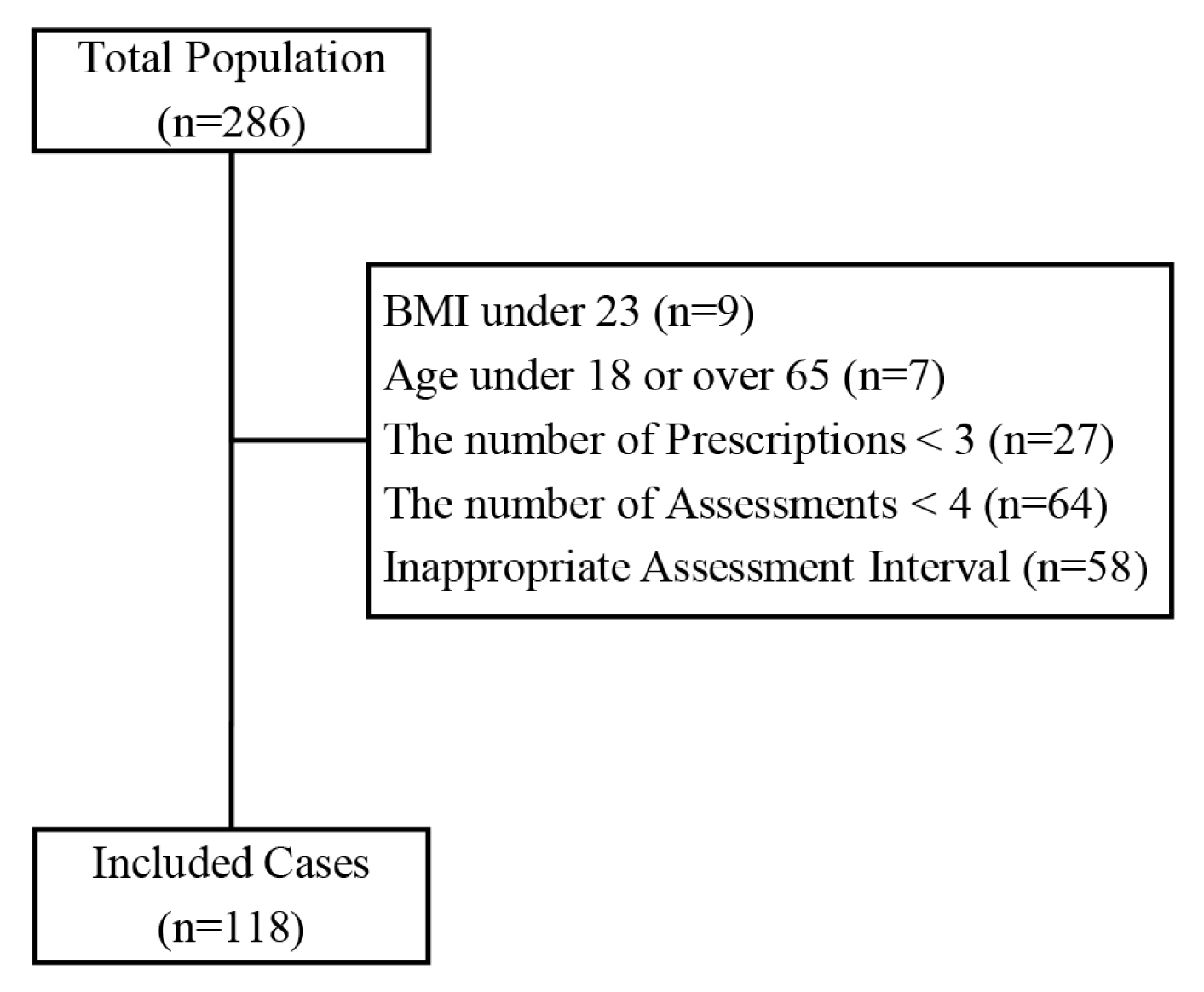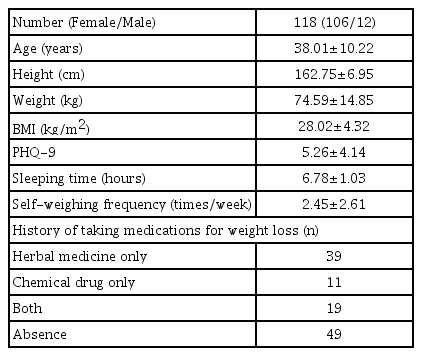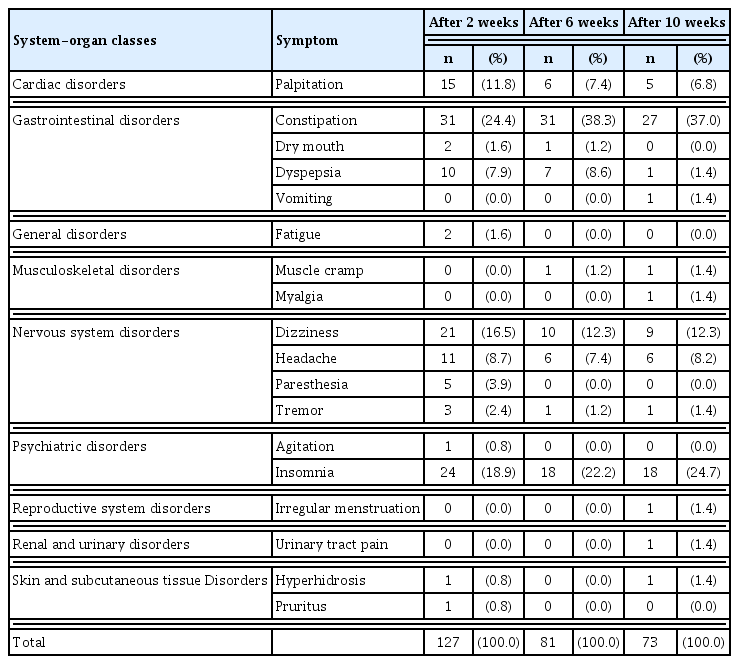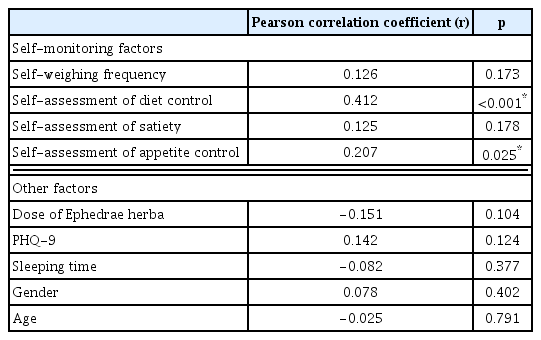References
1. Committee of Clinical Practice Guideline Korean Society for the Study of Obesity. 2018. Treatment guideline of obesity 2018 Seoul/Korea: Korean Society for the Study of Obesity.
2. Obesity Fact Sheet Task Force Team. 2020. 2020 OBESITY FACT SHEET Seoul/Korea: Korean Society for the Study of Obesity.
3. Wadden TA, Osei S. 2002. The treatment of obesity: An overview. In : Wadden TA, Stunkard AJ, eds. Handbook of Obesity Treatment New York: Guilford Press. p. 229–248.
4. Kanfer FH. 1991. Self-Management Methods New York, NY: Pergamon Press.
5. Burke LE, Wang J, Sevick MA. 2011;Self-monitoring in weight loss: a systematic review of the literature. Journal of the American Dietetic Association 111(1):92–102.
https://doi.org/10.1016/j.jada.2010.10.008
.
6. Vanwormer JJ, French SA, Pereira MA, Welsh EM. 2008;The impact of regular self-weighing on weight management: a systematic literature review. The international journal of behavioral nutrition and physical activity 5:54.
https://doi.org/10.1186/1479-5868-5-54
.
7. Zheng Y, Klem ML, Sereika SM, Danford CA, Ewing LJ, Burke LE. 2015;Self-weighing in weight management: a systematic literature review. Obesity (Silver Spring, Md) 23(2):256–265.
https://doi.org/10.1002/oby.20946
.
9. Welsh EM, Sherwood NE, VanWormer JJ, Hotop AM, Jeffery RW. 2009;Is frequent self-weighing associated with poorer body satisfaction? Findings from a phone-based weight loss trial. Journal of nutrition education and behavior 41(6):425–428.
https://doi.org/10.1016/j.jneb.2009.04.006
.
10. Shieh C, Knisely MR, Clark D, Carpenter JS. 2016;Self-weighing in weight management interventions: A systematic review of literature. Obesity research & clinical practice 10(5):493–519.
https://doi.org/10.1016/j.orcp.2016.01.004
.
11. Gokee-Larose J, Gorin AA, Wing RR. 2009;Behavioral self-regulation for weight loss in young adults: a randomized controlled trial. The international journal of behavioral nutrition and physical activity 6:10.
https://doi.org/10.1186/1479-5868-6-10
.
12. Obesity Society. 2014. 2013 AHA/ACC/TOS guideline for the management of overweight and obesity in adults: a report of the American College of Cardiology/American Heart Association Task Force on Practice Guidelines and The Obesity Society. Circulation 129(25 Suppl 2)S102–S138.
https://doi.org/10.1161/01.cir.0000437739.71477.ee
.
13. Hwang Mi-Ja, Shin Hyun-Dae, Song Mi-Yeon. 2007;Literature Review of Herbal Medicines on Treatment of Obesity Since 2000-Mainly about Ephedra Herba. Journal of Society of Korean Medicine for Obesity Research 7(1):39–54.
14. Song Yun-Kyung, Lim Hyung-Ho. 2007;Clinical Application of Ma Huang in the Obesity Treatment. Journal of Society of Korean Medicine for Obesity Research 7(1):1–7.
15. Greenway FL, De Jonge L, Blanchard D, Frisard M, Smith SR. 2004;Effect of a dietary herbal supplement containing caffeine and ephedra on weight, metabolic rate, and body composition. Obesity research 12(7):1152–1157.
https://doi.org/10.1038/oby.2004.144
.
16. The Society of Korean Medicine for Obesity Research. 2016. Obesity Korean Medicine Clinical Practice Guideline Seoul/Korea: KOREA INSTITUTE OF ORIENTAL MEDICINE.
18. Spitzer RL, Kroenke K, Williams JB. 1999;Validation and utility of a self-report version of PRIME-MD: the PHQ primary care study. Primary Care Evaluation of Mental Disorders. Patient Health Questionnaire. JAMA 282(18):1737–1744.
https://doi.org/10.1001/jama.282.18.1737
.
19. Wadden TA, Berkowitz RI, Womble LG, Sarwer DB, Phelan S, Cato RK, Hesson LA, Osei SY, Kaplan R, Stunkard AJ. 2005;Randomized trial of lifestyle modification and pharmacotherapy for obesity. The New England journal of medicine 353(20):2111–2120.
https://doi.org/10.1056/NEJMoa050156
.
20. Song Mi-Young, Kim Ho-Jun, Lee Myeong-Jong. 2006;The Safety Guidelines for use of Ma-huang in Obesity Treatment. Journal of Korean Oriental Association for Study of Obesity 6(2):17–27.
21. Johansson K, Neovius M, Hemmingsson E. 2014;Effects of anti-obesity drugs, diet, and exercise on weight-loss maintenance after a very-low-calorie diet or low-calorie diet: a systematic review and meta-analysis of randomized controlled trials. The American journal of clinical nutrition 99(1):14–23.
https://doi.org/10.3945/ajcn.113.070052
.
22. Parretti HM, Jebb SA, Johns DJ, Lewis AL, Christian-Brown AM, Aveyard P. 2016;Clinical effectiveness of very-low-energy diets in the management of weight loss: a systematic review and meta-analysis of randomized controlled trials. Obesity reviews: an official journal of the International Association for the Study of Obesity 17(3):225–234.
https://doi.org/10.1111/obr.12366
.
23. Seimon RV, Wild-Taylor AL, Keating SE, McClintock S, Harper C, Gibson AA, et al. 2019;Effect of Weight Loss via Severe vs Moderate Energy Restriction on Lean Mass and Body Composition Among Postmenopausal Women With Obesity: The TEMPO Diet Randomized Clinical Trial. JAMA network open 2(10):e1913733.
https://doi.org/10.1001/jamanetworkopen.2019.13733
.
24. Steinberg DM, Tate DF, Bennett GG, Ennett S, Samuel-Hodge C, Ward DS. 2013;The efficacy of a daily self-weighing weight loss intervention using smart scales and e-mail. Obesity (Silver Spring, Md) 21(9):1789–1797.
https://doi.org/10.1002/oby.20396
.
25. VanWormer JJ, Linde JA, Harnack LJ, Stovitz SD, Jeffery RW. 2012;Self-weighing frequency is associated with weight gain prevention over 2 years among working adults. International journal of behavioral medicine 19(3):351–358.
https://doi.org/10.1007/s12529-011-9178-1
.
26. BLOSSOM Clinical Trial Group. 2011;A one-year randomized trial of lorcaserin for weight loss in obese and overweight adults: the BLOSSOM trial. The Journal of clinical endocrinology and metabolism 96(10):3067–3077.
https://doi.org/10.1210/jc.2011-1256
.
27. PIONEER 8 Investigators. 2019;Efficacy, Safety, and Tolerability of Oral Semaglutide Versus Placebo Added to Insulin With or Without Metformin in Patients With Type 2 Diabetes: The PIONEER 8 Trial. Diabetes care 42(12):2262–2271.
https://doi.org/10.2337/dc19-0898
.





